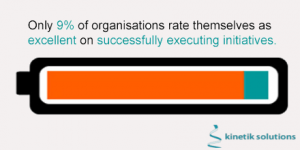
Transformational Change: What It Is and How It Works
Almost 59% of corporations fail to meet at least one of their transformational change objectives.[1]
Why is this number so dismal? All large organisations are likely to go through change processes, whether that’s introducing a new IT system, developing new products or reorganising into a new structure. Transformational change, however, can be particularly difficult to achieve: it demands comprehensive innovation, flexibility and a willingness to work with abstract ideas.
All companies go through transformational changes; however how they respond to these changes makes the difference. Once dominating the mobile phone industry, Nokia decided to undertake several serious operational transformations during its 150 years of history, in order to stay in business. First it sold its mobile business to Microsoft, and then bought all the shares of Nokia (which was 50-50 at the time) from Siemens. Then they focused on a new corporate strategy to adapt to all these changes. Nokia has grown immensely since 2012, and survived major change[2].
Through transformational change, more than just day-to-day work practices are affected. Transformational change requires innovative thoughts and attitudes, without which the change cannot be sustained.
When an organisation is seeking to implement large-scale changes, the weaknesses in the existing way of working become obvious. This is one of the many challenges of implementing transformational change processes.
Effective, sustainable change requires competent leadership.
Leaders need to be aware of the reasons for change in the preparation stage and the context behind it. They also must adapt to highly leveraged methods and tools, to shape the change process and make it successful.
Even when a change programme results in a short-term success, it is not the end of the story: leaders know that sustainability must be an integral part of the transformation, and this takes time. Thus, patience is an essential virtue for a competent leader.
Leadership is about working with people as they are – using their expertise, relationships and insights to build opportunities, create advantages and develop a common sense of purpose.
The leadership skills such as coaching and being resourceful are those that are mostly in need.
Leaders understand the processes in an organisation and the dynamic between them, amounting to a more holistic view of how the organisation works.
The tools of transformational change
My new book, The Art of Transformational Change: A Handbook for Managers and Leaders seeks to provide leaders and the people they influence with the skills and methods to execute a successful change programme.
Key abilities and processes include:
- Examining the dimensions of value: Capturing customer perceptions and understanding the goal of new changes
- Understanding the importance of clear-outs: Vital practices for renewing both information and materials in an organisation
- Using the RACI tool: A framework for establishing and communicating who does what in any change programme
- Establishing a system of continuous review: Setting up daily, weekly, monthly and quarterly checks of an organisation’s practices
- Managing high performance teams: Creating and dismantling high performance teams in change operations
- Problem-solving using TRIZ: An innovative tool that offers low-cost solutions to issues arising in change programmes
- Developing your systems thinking: Better understanding what impacts what in complex transformation, especially in difficult cases
- Failing faster and learning quickly: Piloting end-to-end processes to identify and resolve problems as fast as possible.
One of the reasons that change strategies result in failure is that they are often disconnected from both employees and clients.
The strategies above are designed to help organisations involved in transformational change to better understand, institute and adapt to it.
The 30% and How to join them
Transformational excellence in an organisation is about flexibility. Typically, it is achieved through outstanding teamwork and skilful adjustments to the change programme.
Sole focus on top-down command-and-control styles of management or bottom-up training and motivation investment approaches do not nourish the change process.
The techniques listed above and those detailed in The Art of Transformational Change offer managers the opportunity to learn important lessons, avoid mistakes and apply the right practice when it comes to change.
70% of businesses fail to deliver transformational change successfully.[3] Don’t join their ranks. Plan, develop and sustain your change programme – be part of the 30%.
Ketan Varia with editorial support from Burcu Atay.
[1] Hans Jorgenson, Lawrence Owen and Andreas Neus, Making Change Work: Global Study, (New York: IBM Global Services, 2008).
[2] http://company.nokia.com/en/about-us
[3] Scott Keller and Carolyn Aiken, The Inconvenient Truth about Change, (McKinsey & Company, 2008).

